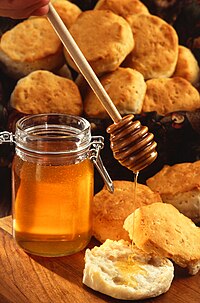
Photo from wikipedia
Abstract Scaffolds used in skin tissue engineering must mimic the native function of the extracellular matrix (ECM) and facilitate the fibroblast cell response for new tissue growth. In this study,… Click to show full abstract
Abstract Scaffolds used in skin tissue engineering must mimic the native function of the extracellular matrix (ECM) and facilitate the fibroblast cell response for new tissue growth. In this study, a novel dressing scaffold based on polyurethane (PU) with sesame oil, honey, and propolis was fabricated by electrospinning. Scanning electron microscopy (SEM) images showed that the diameter of the electrospun scaffolds decreased by blending sesame oil (784 ± 125.46 nm) and sesame oil/honey/propolis (576 ± 133.72 nm) into the PU matrix (890 ± 116.911 nm). Fourier infrared (FT-IR) and thermogravimetric (TGA) analysis demonstrated the formation of hydrogen bonds and interaction between PU and sesame oil, honey, and propolis. Contact-angle measurement indicated reduced wettability of PU/sesame oil scaffold (114 ± 1.732) and improved wettability (54.33 ± 1.528) in the PU/sesame oil/honey/propolis scaffold. Further, tensile tests and atomic force microscopy (AFM) analysis indicated that the fabricated composite membrane exhibited enhanced mechanical strength and reduced surface roughness compared to the pristine PU. The developed composite displayed less toxicity to the red blood cells (RBC’s) compared to the pristine PU. Cytotoxicity assay showed enhanced cell viability of HDF in electrospun scaffolds than pristine PU after 72 h culture. These enhanced properties of the developed scaffolds suggest the potential of utilizing them in skin tissue engineering.
Journal Title: International Journal of Polymer Analysis and Characterization
Year Published: 2019
Link to full text (if available)
Share on Social Media: Sign Up to like & get
recommendations!